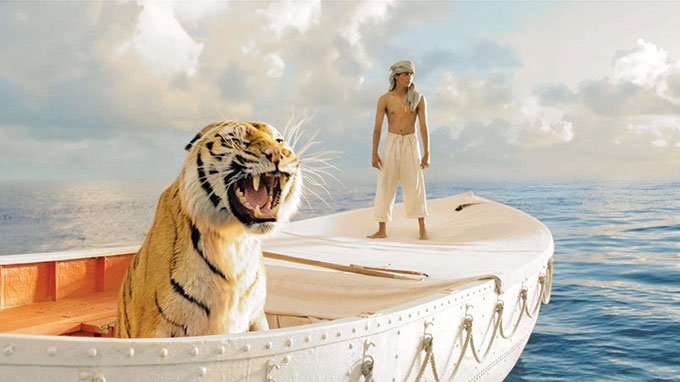Life of Pi
by M. Faust

Tiger, Caution
Life of Pi
Do yourself a favor: Don’t read past the end of this paragraph. Whether or not you want to take my word for it that Ang Lee’s Life of Pi is the best film of the year, maybe even of the past decade, trust me that nothing I can tell you would not be better experienced by you in a theater, coming to it with no preconceptions.
It is certainly this year’s equivalent of Hugo, a movie which demonstrates that special effects do not have to become an end in themselves, that in the hands of a capable filmmaker like Scorsese or Lee, they can expand the art of cinema without losing its historical virtues.
I hesitate to say that Life of Pi is filmed with digital effects and other kinds of movie magic because I don’t want to give you the wrong idea. I was well into the movie before a scene roused me from my acceptance and made me realize that what I was watching could not actually have taken place and been captured by photography. If you go into this film expecting that, you will certainly be conscious of it, but little if anything that is on screen here demands that you ask, “Who is that man behind the curtain?”
Life of Pi was adapted from the novel by Yann Martel, which won the Man Booker Prize for Fiction in 2002. The title may be inappropriate for the film, which focuses an a small period of the main character’s life, which he spends on a lifeboat adrift in the Pacific Ocean. He is alone but for one other passenger: a tiger.
How this comes to be is plausible enough, and the story that takes us there does not test our patience. Pi is an Indian boy, originally named Piscene after his uncle’s favorite swimming pool. He shortens it in the hope that his schoolmates (who insist on pronouncing it “Pissing”) will think of the mathematical symbol instead. As a grown man, he is telling his tale to a writer, who has been told by a mutual acquaintance that Pi’s story “will make you believe in God,” a promise you can take or leave.
Pi’s story, the bulk of which is set on that boat, is existential and allegorical. It is perhaps fantastical. (Would the survival manual really include instructions for those who must share the boat with “large ferocious carnivores”? Or is that a hallucination?) These are questions to ponder at the end of the film.
While you are watching it, Life of Pi is never less than completely and captivating real. There are no Disney-fied bonding moments between the boy and the beast: We never doubt that, given the chance, the tiger would eat his companion, or kill him with a swat of indifference. But Pi does bond with the tiger, which saves his life by threatening it on a regular basis.
Lee, cinematographer Claudio Miranda (The Curious Case of Benjamin Button), and the production crew find endless ways to make the endless sea and sky fill the screen in new ways, without ever making us feel like we are watching a simple display of digital preening. They may skirt the edge with a detour to an island filled with hundreds of thousands of meerkats, but it works so well that you can’t begrudge them.
Aside from a few reminders of the natural order of carnivores, there is nothing in this movie that should prevent you from taking every family member you can squeeze into the car to see it. Or see it alone, the better to avoid distraction from the screen. Life of Pi is a magnificent spectacle that will expand all horizons and delight all ages.
Watch the trailer for Life of Pi
|
Issue Navigation> Issue Index > v11n47 (Gift Guide, week of Thursday, November 22) > Life of Pi This Week's Issue • Artvoice Daily • Artvoice TV • Events Calendar • Classifieds |









 Current Issue
Current Issue